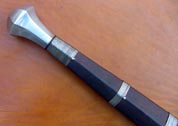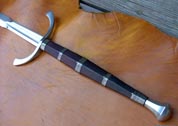|
|

The Dane
Limited
Edition Medieval Danish Two Handed War Sword
(Oakeshott XVIIIe)
Oakeshott indicates that
the Type XVIIIe, with its long narrow diamond-shaped blade and even more
narrow ricasso, was quite common in Denmark -- with many surviving examples
that are either Danish in origin or possibly Italian.
The Danish style of XVIIIe seems to also be characterized by the down-turned
quillons and a very long banded grip (either solid metal bands or by wire.)
Our Dane is based on Peter Johnsson's documentation of originals of this
type. XVIIIe's are visually imposing, yet still light and swift enough
to deliver terrible blows and piercing thrusts.
The grip for the Dane is stabilized wood wrapped with leather and with sections bound
with metal wire.
This is a dedicated thruster, but as with many of these thick, stiff and
pointy swords, the cutting performance should not be underestimated. This
is a sword made for armoured fighting. It is like a great long and sharp-edged
awl with a positive massive feel. Not sluggish. Very stiff, nasty and
aggressive. An unusual and different type.
A Limited Edition Hand Crafted Collectible Sword
This sword is offered in a limited edition of only 100 collectible swords
worldwide.
Specifications
Overall length: 58" (147 cm)
Blade length: 42" (106.7 cm)
Blade width at base: 1.4" (3.5 cm)
CoG: 4" (10.2 cm)
CoP: 24.5" (62.2 cm)
Weight: 4 lbs 10 oz (2.1 kg)
Name That Sword Contest II Winner:
Craig Peters
"My suggestion for this sword is that it be named, quite simply, the Dane.
The name clearly suggests the nation of origin from the sword, and there
is a beautiful simplicity to it. A simple and yet majestic name for a
majestic sword."
Please specify your sword's grip color (see the standard grip colors here.)
The Dane ... $1,980
This sword is offered in a limited
edition of 100 swords worldwide.
Here is some additional information about this sword type from Peter
Johnsson:
"The Dane is an example of one of the more advanced or extreme blade
designs in the history of the European sword.
Oakeshott classified these and put them as subclass XVIIIe in the large
and varied type XVIII group. They differ dramatically when compared to
any other type XVIIIa, b, c or d, however.
The grip is typically very long in proportion to the blade. Grip length
can be a third or more of the total length. Quite a few of these weapons
have survived and now reside as excavated specimens in museum store rooms
in Scandinavia. I have had the privilege to see and handle several of
them.
Swords with extremely long grips were popular in Scandinavia and possibly
northern Germany in the 15th C. Interestingly, swords of similar size
and proportions were also made/used in Italy at the same time (one fine
example is exhibited in Brescia).
These swords will show some variation within the family. I am not sure
all can be comfortable classified as XVIIIe“s. Despite sharing the same
general proportions, there is quite some variation to the blades of these
weapons.
Sometimes the blade rather shares characteristics with type XIII, XV or
even XX. All are obviously intended for two handed use. Most are large,
but some have blade lengths more in scale with single handed swords. One
subgroup have blades that are fairly broad at the base, tapering to a
narrow spade shaped point. These are flexible, thin bladed cutting swords.
Sometimes the blade has one or several fullers. There is no ricasso on
these blades. The grip is sometimes very long. I have seen one example
where the grip was almost equal in length to the blade. The guard is often
wide and slightly curved. Pommel is often wedged shaped or spherical.
Others have blades of moderate width that seem to favor thrust and cut
equally. They do not have a ricasso. Section can be diamond shaped or
lenticular. Some have fullers and could be classified as type XX swords
with extremely long grips. The guard can sometimes be C-shaped with both
arms curving to the front side of the grip at right angles to the blade;
like an S-curved guard gone wrong. Others have a pretzel shaped guard.
Both these guard types seem to be locally favored in the Scandinavian
countries. Pommels are commonly spherical or a small octagonal scent stoppers.
The Dane is a representative of those perhaps most characteristic or familiar
of the long gripped Scandinavians. These were the swords that Oakeshott
described in his classification and included as type XVIIIe.
They stand out from the other long gripped swords because of the character
of the blade, and that they all have a ricasso. The blade is usually not
so broad but very thick and stout with a diamond shaped cross section.
The point is strong and awl like. The proportion grip/blade length is
often about 2:5.
The guard is normally curved towards the point, sometimes just a more
or less straight bar. The pommel is almost always a scent stopper with
octagonal section.
In many cases there are traces of a rather unique grip cover: it has short
sections tightly wrapped with iron wire, serving as reinforcement and
providing good gripping. The wood could be left plain or covered by leather
under the wire binding. In some cases there could have been a leather
rain guard covering the cross and the mount of the scabbard.
The feel of these weapons is special and quite apart from most any other
type of sword. The thickness of the blade and ricasso is striking. When
used in half swording, they could almost qualify as a kind of short pole
arm: its thick, stiff blade and tremendous awl point would have been devastating
when the swordsman put the full momentum of his body behind a thrust.
The length of grip and blade together provides long reach in both cut
and thrust, while the balance provides surprising maneuverability. The
point of balance is close to the guard, but the sword still has a positive
blade presence because of its mass. They are massive weapons, but agile
despite their size.
When seeing swords such as these up close it becomes obvious they were
made to be strong thrusting swords. It is equally obvious that blades
like these must have been developed to be able to deal and take blows
in fighting between fully armoured opponents. Even if a sword cut can
never really be expected to cleave armour, a blow from a blade with the
mass and stiffness of these swords would still deal terrible damage, stunning
or perhaps even killing. The point could conceivably penetrate the thinner
parts of plate armour with a good hit, but thrusts would naturally be
aimed at gaps and openings, where only mail and/or padding was the protection.
To a less than completely armoured opponent the edge and point of these
swords would be equally lethal.
They give a strong impression of being made for battlefield use. They
have the mass, heft and agility to be reliable no nonsense killing tools.
A trained swordsman in full armour equipped with a sword of this type
must have been truly terrifying. Perhaps these swords could also have
served well on horseback. The long grip, stout guard and strong ricasso
makes it possible to couch the sword like a lance, resting the guard across
the armpit and breastplate. The reach is not long, but in some situations
this might have been a good thing. The use of swords as lances is described
in some medieval texts.
A number of these swords has been found in the graves of Danish Noblemen
dating to the third quarter of the 15th C. Quite a few has also been found
as loose finds in other parts of Scandinavia. It is impossible to say
whether these weapons saw a popularity among the fighting men from all
parts of Scandinavia, or if the finds are remains of Danish knights and
men-at-arms who fought and fell on foreign soil."
|







